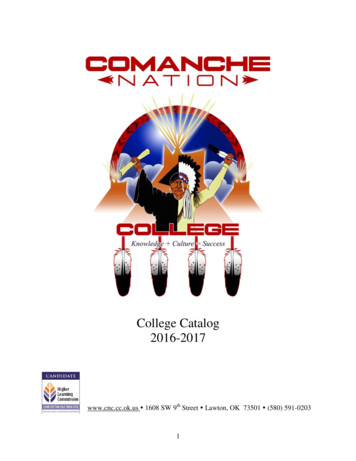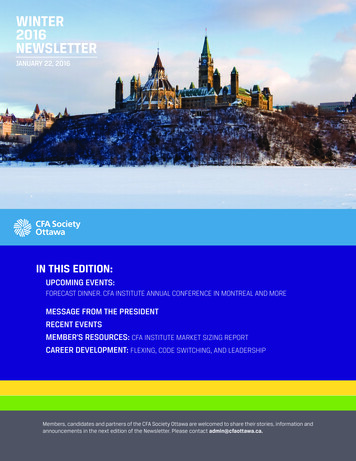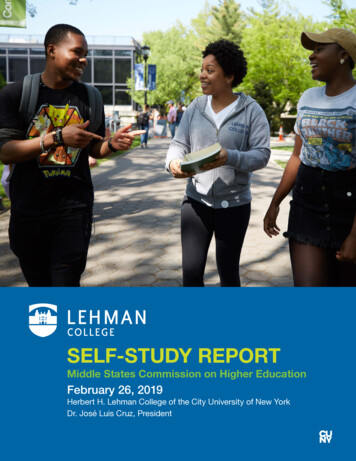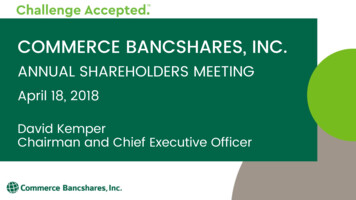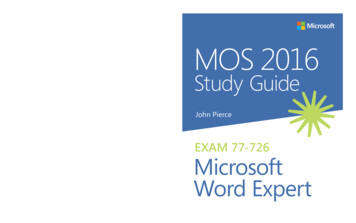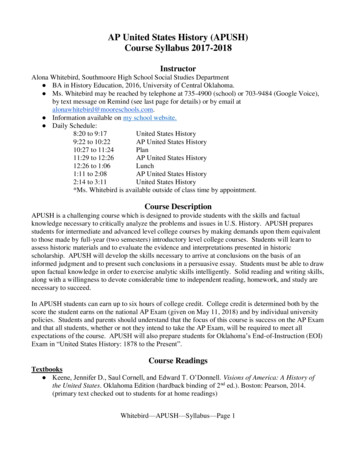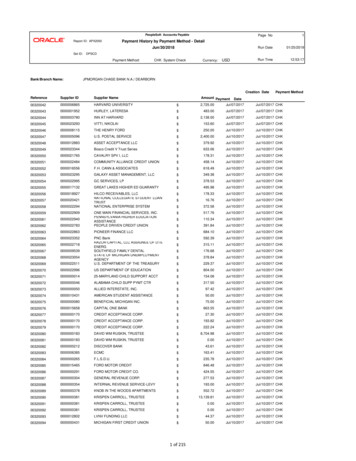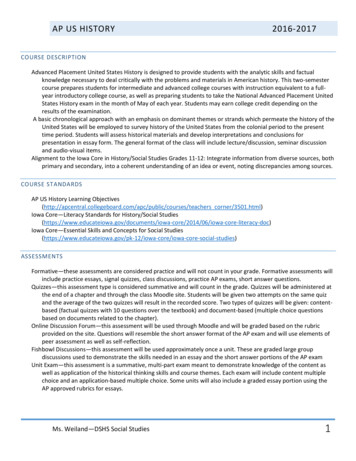
Transcription
AP US HISTORY2016-2017COURSE DESCRIPTIONAdvanced Placement United States History is designed to provide students with the analytic skills and factualknowledge necessary to deal critically with the problems and materials in American history. This two-semestercourse prepares students for intermediate and advanced college courses with instruction equivalent to a fullyear introductory college course, as well as preparing students to take the National Advanced Placement UnitedStates History exam in the month of May of each year. Students may earn college credit depending on theresults of the examination.A basic chronological approach with an emphasis on dominant themes or strands which permeate the history of theUnited States will be employed to survey history of the United States from the colonial period to the presenttime period. Students will assess historical materials and develop interpretations and conclusions forpresentation in essay form. The general format of the class will include lecture/discussion, seminar discussionand audio-visual items.Alignment to the Iowa Core in History/Social Studies Grades 11-12: Integrate information from diverse sources, bothprimary and secondary, into a coherent understanding of an idea or event, noting discrepancies among sources.COURSE STANDARDSAP US History Learning ublic/courses/teachers corner/3501.html)Iowa Core—Literacy Standards for History/Social -core/2014/06/iowa-core-literacy-doc)Iowa Core—Essential Skills and Concepts for Social these assessments are considered practice and will not count in your grade. Formative assessments willinclude practice essays, signal quizzes, class discussions, practice AP exams, short answer questions.Quizzes—this assessment type is considered summative and will count in the grade. Quizzes will be administered atthe end of a chapter and through the class Moodle site. Students will be given two attempts on the same quizand the average of the two quizzes will result in the recorded score. Two types of quizzes will be given: contentbased (factual quizzes with 10 questions over the textbook) and document-based (multiple choice questionsbased on documents related to the chapter).Online Discussion Forum—this assessment will be used through Moodle and will be graded based on the rubricprovided on the site. Questions will resemble the short answer format of the AP exam and will use elements ofpeer assessment as well as self-reflection.Fishbowl Discussions—this assessment will be used approximately once a unit. These are graded large groupdiscussions used to demonstrate the skills needed in an essay and the short answer portions of the AP examUnit Exam—this assessment is a summative, multi-part exam meant to demonstrate knowledge of the content aswell as application of the historical thinking skills and course themes. Each exam will include content multiplechoice and an application-based multiple choice. Some units will also include a graded essay portion using theAP approved rubrics for essays.Ms. Weiland—DSHS Social Studies1
AP US HISTORY2016-2017CONTENTUnit 1: Colonial Beginnings (1491-1754) Periodization: Period 1 (1491-1607) and Period 2 (1607-1754) Essential Question: Compare and contrast the development and characteristics of the colonial regions. Text reading: Brinkley—chapters 1-3 Thematic Review Questions:American and How did the identities of colonizing and indigenous American societies change as a result ofNationalcontact in the Americas? What were the similarities and differences among theIdentity (ID)development of English, Spanish, Dutch, and French colonies in America?Work,How did the Columbian Exchange—the mutual transfer of material goods, commodities,Exchange, andanimals, and diseases—affect interaction between Europeans and natives and amongTechnologyindigenous peoples in North America? How did the policy of mercantilism impact the(WXT)development of the colonial regions? How did the system of slavery develop and impactthe colonial regions?Migration and Where did different groups settle in the Americas (before contact) and how and why did theySettlementmove to and within the Americas (after contact)? From where and why did various(MS)immigrant groups come to America and what impact they had on the colonial regions?Politics andPower (POL)America in theWorld (WOR)GeographyandEnvironment(ENV)Culture andSociety (CUL) How did Spain’s early entry into colonization in the Caribbean, Mexico, and South Americashape European and American developments in this period? How did the colonial regionsof Spain, France, and England compare in their control over their region?How did European attempts to dominate the Americas shape relations between NativeAmericans, Europeans, and Africans? How did competition between European empiresaround the world affect relations among the various peoples in North America?How did pre-contact populations of North America relate to their environments? How didcontact with Europeans and Africans change these relations in North America? How didcolonial members interact with and change the environment while developing theregions? How and why did the English North American colonies develop into distinctregions?How did cultural contact challenge the religious and other values systems of peoples from theAmericas, Africa, and Europe? How did the ideas of the Enlightenment and GreatAwakening impact the development of colonial culture? How did permanent colonizationimpact the development of trade, religion, intellectual life, and political institutions?Assessmento Multiple Choice Chapter Quizzes: Content and Documento Multiple Choice Examo Short Answer Essay--Answer (a), (b), and (c). (2015 Exam) a) Briefly explain ONE important similarity between the British colonies in the Chesapeakeregion and the British colonies in New England in the period from 1607 to 1754. b) Briefly explain ONE important difference between the British colonies in the Chesapeakeregion and the British colonies in New England in the period from 1607 to 1754. c) Briefly explain ONE factor that accounts for the difference that you indicated in (b).Ms. Weiland—DSHS Social Studies2
AP US HISTORY2016-2017Unit 2: Revolutionary America Periodization: Period 3 (1754-1800) Essential Question: How did American political, economic, and social institutions change and/or continue due tothe events of the revolutionary period? Text reading: Brinkley—chapters 4-6 Thematic Review Questions:American andHow did different social group identities evolve during the revolutionary struggle? How didNationalleaders of the new United States attempt to form a national identity?Identity (ID)Work,How did the newly independent United States attempt to formulate a national economy?Exchange, andTechnology(WXT)Migration andHow did the revolutionary struggle and its aftermath reorient white and American IndianSettlementrelations and affect subsequent population movements?(MS)Politics andHow did the ideology behind the revolution affect power relationships between differentPower (POL)ethnic, racial, and social groups? America in theWorld (WOR)How did the revolution become an international conflict involving competing European andAmerican powers? How did the Founding Fathers and first two presidents outline a planfor future foreign relations?GeographyandEnvironment(ENV)Culture andSociety (CUL)How did the geographical and environmental characteristics of regions opened up to whitesettlement after 1763 affect their subsequent development?Why did the patriot cause spread so quickly among the colonists after 1763? How did therepublican ideals of the revolutionary cause affect the nation’s political culture afterindependence?Assessmento Multiple Choice Chapter Quizzes: Content and Documento Multiple Choice Examo Free-Response Question—Evaluate the extent to which the Seven Years’ War (French and IndianWar, 1754–1763) marked a turning point in American relations with Great Britain, analyzing whatchanged and what stayed the same from the period before the war to the period after it.(Periodization Essay—2015) **Self-assessed**Ms. Weiland—DSHS Social Studies3
AP US HISTORY2016-2017Unit 3: New National Period Periodization: Period 4 (1800-1848) Essential Question: Analyze the United States’ ability to create a national unity and identity following theRevolutionary Period. Text reading: Brinkley—chapters 7-12 Thematic Review Questions:American andHow did debates over American democratic culture and the proximity of many differentNationalcultures living in close contact affect changing definitions of national identity?Identity (ID)Work,How did the growth of mass manufacturing in the rapidly urbanizing North affect definitionsExchange, andof and relationships between workers, and those for whom they worked? How did theTechnologycontinuing dominance of agriculture and the slave system affect southern social,(WXT)political, and economic life?Migration andHow did the continued movement of individuals and groups into, out of, and within theSettlementUnited States shape the development of new communities and the evolution of old(MS)communities?Politics andHow did the growth of ideals of mass democracy, including such concerns as expandingPower (POL)suffrage, public education, abolitionism, and care for the needy affect political life anddiscourse?America in the How did the United States use diplomatic and economic means to project its power in theWorld (WOR)western hemisphere? How did foreign governments and individuals describe and reactto the new American nation?GeographyHow did environmental and geographic factors affect the development of sectionalandeconomics and identities?Environment(ENV)Culture andHow did the idea of democratization shape and reflect American arts, literature, ideals, andSociety (CUL)culture? Assessmento Multiple Choice Chapter Quizzes: Content and Documento Multiple Choice Examo Free-Response Question—Some historians have argued that in the years of the early Republic, theGreat Awakening had a more significant impact on American identity than Enlightenment ideas did.Support, modify, or refute this interpretation, providing specific evidence to justify your answer.(Comparison Long Essay—Brinkley) **Peer Reviewed**Ms. Weiland—DSHS Social Studies4
AP US HISTORY2016-2017Unit 4: Division, War, and Reconstruction Periodization: Period 5 (1844-1877) Essential Question: Evaluate the extent to which the Civil War and Reconstruction continued or changedAmerican society. Text reading: Brinkley—chapters 13-15 Thematic Review Questions:American andHow did migration to the United States change popular ideas of American Identity andNational Identitycitizenship as well as regional and racial identities? How did the conflicts that led to the(ID)Civil War change popular ideas about national, regional, and racial identities throughoutthis period?Work, Exchange, How did the maturing of northern manufacturing and the adherence of the South to anand Technologyagricultural economy change the national economic system by 1877?(WXT)Migration andHow did the growth of mass migration to the United States and the railroad affectSettlement (MS)settlement patterns in cities and the West?Politics andWhy did attempts at compromise before the war fail to prevent the conflict? To whatPower (POL)extent, and in what ways, did the Civil War and Reconstruction transform Americanpolitical and social relationships?America in theHow was the American conflict over slavery part of larger global events?World (WOR)GeographyHow did the end of slavery and technological and military developments transform theandenvironment and settlement patterns in the South and the West?Environment(ENV)Culture andHow did the doctrine of Manifest Destiny affect debates over territorial expansionism andSociety (CUL)the Mexican War? How did the Civil War struggle shape Americans’ beliefs aboutequality, democracy, and national destiny? Assessmento Multiple Choice Chapter Quizzes: Content and Documento Multiple Choice Examo Free-Response Question—Some historians have argued that Reconstruction was largely a failure.Support, modify, or refute this interpretation, providing specific evidence to justify your answer.(Change over Time Essay—Brinkley)**Graded**Ms. Weiland—DSHS Social Studies5
AP US HISTORY2016-2017Unit 5: Gilded Age Periodization: Period 6 (1865-1898) Essential Question: Evaluate the changes and continuities in American identity as a result of industrializationduring the period of 1865-1900. Text reading: Brinkley—chapters 16-19 (first half) Thematic Review Questions:American andHow did the rapid influx of immigrants from other parts of the world than northern andNationalwestern Europe affect debates about American national identity?Identity (ID)Work,How did technological and corporate innovations help to vastly increase industrialExchange, andproduction? What was the impact of these innovations on the lives of working people?Technology(WXT)Migration andHow and why did the sources of migration to the United States change dramatically duringSettlementthis period?(MS)Politics andHow did the political culture of the Gilded Age reflect the emergence of new corporatePower (POL)power? How successful were the challenges to this power? Why did challenges to thispower fail?America in the How did the search for new global markets affect American foreign policy and territorialWorld (WOR)ambitions?GeographyIn what ways, and to what extent, was the West “opened” for further settlement throughandconnection to eastern political, financial, and transportation systems?Environment(ENV)Culture andHow did artistic and intellectual movements both reflect and challenge the emergingSociety (CUL)corporate order? Assessmento Multiple Choice Chapter Quizzes: Content and Documento Multiple Choice ExamDocument-based Question— Analyze major changes and continuities in the debates over national identityduring the Gilded Age as a result of the rise of big business. (DBQ Essay—Brinkley) **Collaborative/SelfAssessed**Ms. Weiland—DSHS Social Studies6
AP US HISTORY2016-2017Unit 6: Expansion and Progressivism (1890-1929) Periodization: Period 7 (1890-1945) Essential Question: Evaluate the causes and effects of imperialism and progressive reform. Text reading: Brinkley—chapters 19-22 Thematic Review Questions:American andHow did continuing debates over immigration and assimilation reflect changing ideals ofNationalnational and ethnic identity? How did class identities change in this period?Identity (ID)Work,How did movements for political and economic reform take shape in this period, and howExchange, andeffective were they in achieving their goals?Technology(WXT)Migration andWhy did public attitudes towards immigration become negative during this time period?SettlementHow and why did people migrate within the U.S. during this time period?(MS)Politics andHow did reformist ideals change as they were taken up by reformers in different timePower (POL)periods? Why did opposition emerge to various reform programs?America in theWorld (WOR)GeographyandEnvironment(ENV)Culture andSociety (CUL) Why did U.S. leaders decide to become involved in global conflicts such as the SpanishAmerican War and World War I? How did debates over intervention reflect public viewsof America’s role in the world?Why did reformers seek for the government to wrest control of the environment andnational resources from commercial interests?How did “modern” cultural values evolve in response to developments in technology? Howdid debates over the role of women in American public life reflect changing socialrealities?Assessmento Multiple Choice Chapter Quizzes: Content and Documento Multiple Choice Examo Free-Response Question—Some historians have argued that supporters of Philippine and LatinAmerican intervention at the turn of the 20th century were primarily motivated by economicinterests. Support, modify, or refute this interpretation, providing specific evidence to justify youranswer. (Causation Long Essay—Brinkley) **Peer Reviewed**Ms. Weiland—DSHS Social Studies7
AP US HISTORY2016-2017Unit 7: Great Depression and World War II (1921-1945) Periodization: Period 7 (1890-1945) Essential Question: Analyze the governmental response to domestic and world crisis of the period. Text reading: Brinkley—chapters 23-26 Thematic Review Questions:American andHow did continuing debates over immigration and assimilation reflect changing ideals ofNationalnational and ethnic identity? How did class identities change in this period?Identity (ID)Work,How did movements for political and economic reform take shape in this period, and howExchange, andeffective were they in achieving their goals?Technology(WXT)Migration andWhy did public attitudes towards immigration become negative during this time period?SettlementHow and why did people migrate within the U.S. during this time period?(MS)Politics andHow did reformist ideals change as they were taken up by reformers in different timePower (POL)periods? Why did opposition emerge to various reform programs?America in theWorld (WOR)GeographyandEnvironment(ENV)Culture andSociety (CUL) Why did U.S. leaders decide to become involved in global conflicts such as World War II?How did debates over intervention reflect public views of America’s role in the world?Why did reformers seek for the government to wrest control of the environment andnational resources from commercial interests?How did “modern” cultural values evolve in response to developments in technology? Howdid debates over the role of women in American public life reflect changing socialrealities?Assessmento Multiple Choice Chapter Quizzes: Content and Documento Multiple Choice Examo Document-Based Question—Some historians have argued that the New Deal was largely a success.Support, modify, or refute this interpretation, providing specific evidence to justify your answer.(Change over Time Long Essay—Brinkley) **Graded**Ms. Weiland—DSHS Social Studies8
AP US HISTORY2016-2017Unit 8: Cold War and Global Power Periodization: Period 8 (1945-1980) Essential Question: Analyze the extent to which American economic, social, and political institutions changedduring the Cold War period as compared to the period following World War I. Text reading: Brinkley—chapters 27-30 Thematic Review Questions:American andHow did the African-American Civil Rights movement affect the development of otherNationalmovements based on asserting the rights of different groups in American society? HowIdentity (ID)did American involvement in the Cold War affect debates over American nationalidentity?Work,How did the rise of American manufacturing and global economic dominance in the yearsExchange, andafter World War II affect standards of living among and opportunities for different socialTechnologygroups?(WXT)Migration andHow did the growth of migration to and within the United States influence demographicSettlementchange and social attitudes in the nation?(MS)Politics andHow did the changing fortunes of liberalism and conservatism in these years affect broaderPower (POL)aspects of social and political power?America in theWorld (WOR)GeographyandEnvironment(ENV)Culture andSociety (CUL) Why did Americans endorse a new engagement in international affairs during the Cold War?How did this belief change over time in response to particular events?Why did public concern about the state of the natural environment grow during this period,and what major changes in public policy did this create?How did changes in popular culture reflect or cause changes in social attitudes? How did thereaction to these changes affect political and public debates?Assessmento Multiple Choice Chapter Quizzeso Multiple Choice Examo Short Answer Essay: Use your knowledge of United States History to answer a, b, and c. a) Describe ONE of the rapid economic and social changes in American society that fostereda sense of optimism in the years following World War II. b) Briefly explain the impact of this change on ONE of the following. Identity Politics Environment c) Provide ONE piece of historical evidence to support your explanation.**Graded**Ms. Weiland—DSHS Social Studies9
AP US HISTORY2016-2017Unit 9: Contemporary America Periodization: Period 9 (1980-Present) Essential Question: Evaluate the future of the United States American in terms of economics, social, political,and diplomatic affairs. Text reading: Brinkley—chapters 31-32 Thematic Review Questions:American andHow did demographic and economic changes in American society affect popular debatesNationalover American national identity?Identity (ID)Work,How did the shift to a global economy affect American economic life? How did scientific andExchange, andtechnological developments in these years change how Americans lived and worked?Technology(WXT)Migration andHow did increased migration raise questions about American identity and affect the nationSettlementdemographically, culturally, and politically?(MS)Politics andHow successful were conservatives in achieving their goals? To what extent did liberalismPower (POL)remain influential politically and culturally?America in theWorld (WOR)GeographyandEnvironment(ENV)Culture andSociety (CUL) How did the end of the Cold War affect American foreign policy? How did the terroristattacks of September 11, 2001 impact America’s role in the world?How did debates over climate change and energy policy affect broader social and politicalmovements?How did technological and scientific innovations in areas such as electronics, biology,medicine, and communications affect society, popular culture, and public discourse?How did a more demographically diverse population shape popular culture?Assessmento Multiple Choice Chapter Quizzeso Multiple Choice ExamMs. Weiland—DSHS Social Studies10
AP US HISTORY2016-2017HISTORICAL THINKING SKILLSThese skills reflect those used by professional historians. Students are expected to use and work towardmastery of the skills while studying the time periods addressed by the AP U.S. History curriculum.Analyzing Historical Sources and Evidenceo Primary sources: analyzing evidence—content and sourcingo Secondary sources: interpretationMaking Historical Connectionso Comparisono Contextualizationo SynthesisChronological Reasoningo Causationo Patterns of Continuity and Change over Timeo PeriodizationCreating and Supporting an Argumento Argumentationo Using evidence to support an argumentINSTRUCTIONAL STRATEGIESCornell Notes—reading guide to be used with the text reading. It is an outline format based on theexpectations of Cornell University.Document-based Question (DBQ)—this is a format for essay writing which will be used for practice, addedevidence, and graded essays. Students will be provided documents and will be expected to assess thedocuments looking for point of view, context, purpose, audience, etc. and then apply the documents toa specified question. In practice this will be accompanied by a DBQ planner, an outline preparingstudents to write an essay without the pressure of writing a whole essay.Discussion Notes—a reading guide used to prepare for in class fishbowl discussions. These are graded largegroup discussions which focus on the content and the historical thinking skills.Discussion Web—reading guide for primary source documents and secondary historical interpretation inwhich students will find evidence for both sides of an argument. A discussion will follow in class wherestudents can use the evidence to defend their point of view.Historical Sourcing Investigation (HSI)—a reading and discussion strategy focused on historical interpretationover time. Students will read various text entries from differing periods of time, summarize the mainpoints, and contextualize the time period. In class, students will work together to find consistentcorroborating evidence as well as variable in the evidence. Other forms of evidence are often presentedin class as well. Students finish the class by writing their version of the events being studied.HOOPS—reading guide to be used with the text reading. It is formatted as a structured outline.KOI (Knowledge-Observation-Interpretation)—video viewing guide used with movie/documentary clipsranging from 20 minutes to a class period in length. The K box is filled out as homework the night beforeusing a background reading to supply previous knowledge. The O and I boxes are completed in classwhile watching and after watching the video clip.Philosophical chairs—discussion strategy following the use of a discussion web or DBQ packet. Students willbe asked to pick a side of an argument or stay on the fence. Students are expected to defend theirposition using evidence or create questions if on the fence. The goal is to create an historical argumentas well as convince those on the fence to take a side.Ms. Weiland—DSHS Social Studies11
AP US HISTORY2016-2017QAR—reading guide for text reading; this strategy is formatted with varying types of questions to beanswered while reading the text.RAFT (Role-Audience-Format-Topic)—a writing strategy in which the student role plays a person or groupfrom history to write a historically significant document from the person/group’s perspective. These areshared in class and formatively evaluated for accuracy of the evidence and point of view.Reading Like a Historian—these are lessons from the Stanford History site which focus on the historicalthinking skills.Save the Last Word (STLW)—a reading strategy and discussion technique in one. Students will read aselection with a question in mind. While reading, record quotes which relate to the question and acomment regarding your thoughts of that particular quote. In class students will take turns supplyingquotes and discuss the relevance to the question posed.Structured Academic Controversy (SAC)—a reading and discussion strategy focused on historicalinterpretation and argumentation. Students will be assigned a side of an argument and will readdocuments looking for evidence pertaining to their side. In class students will be placed in groups offour, with 2 side-A members and 2 side-B members. In a structured discussion format each side willpresent their evidence and will end with an open discussion where they must reach a consensus on theargument.Weighing Evidence—discussion strategy following the use of a discussion web. Students will work in groupsto evaluate each piece of evidence and place it on a scale representing two ends of an argument. Groupswill have to defend their placement of the document on the scale.RESOURCESTEXT AND READINGSBrinkley, Alan. American History: Connecting to the Past, Fourteenth AP Edition. New York: McGraw Hill,2012.Supplemental texts/readings:Davis, Kenneth. Don’t Know Much About History. New York: Harper Collins, 2011.Hoffman, Elizabeth Cobbs, et al. Major Problems in American History Vols. 1 and 2, Third Edition. Boston:Wadsworth, 2012.Kennedy, David M. and Thomas A. Bailey. The American Spirit Vols. 1 and 2, Twelfth Edition. Boston:Wadsworth, 2010.Lindaman, Dana and Kyle Ward. History Lessons: How Textbooks From Around the World Portray U.S.History. New York: The New Press, 2004.Madaras, Larry and James M. SoRelle. Taking Sides: Clashing Views in United States History Vols. 1 and 2,Fifteenth Edition. New York: McGraw Hill, 2013.Stanford History Education Group. Reading Like a Historian. http://sheg.stanford.edu.Ward, Kyle. History in the Making. New York: The New Press, 2006.Wood, Ethel. AP United States History: An Essential Coursebook. Reading: WoodYard, 2011.Zinn, Howard. A People’s History of the United States. New York: Harper Perennial Modern Classic, 2005.WEBSITESMoodle: http://moodle.aeak12online.org/AP Central: ted-states-history?ushistBrinkley Book: dex.htmlZinn book: y.htmlMs. Weiland—DSHS Social Studies12
AP US HISTORY2016-2017EXPECTATIONSSTANDARD BEHAVIORS FOR CLASS AND LIFEChoose your friends wisely—in your seating and in group work pick people who will help you be successfuland not lead you into dishonorable and disrespectful behaviors.Choose the right path—think before you actBe patient and kind—respect others opinions and background as well as your ownTake responsibility—if you mess up, stand up to it. Don’t blame others or make excusesTurn wounds into wisdom—learn from the mistakes and change the behaviorThese all require mature behavior. It is expected you will act mature at all times.ATTENDANCEBeing in class is important. In missing class you miss discussions, explanation, and guidance. Success in thiscourse is built on being here.MAKEUP WORKWhen absent, deadlines for missed work will be negotiated with me. It is expected you will make up thework by the deadline arranged. If absences will be extended please contact me for your work.PUNCTUALITYYou are expected to be on time to class every day. Instructions and goals for the day are announced at thebeginning and if you come in late you miss that critical information. If you do arrive late, please put yourpass on the podium and take seat. No not interrupt the class. With every tardy you will also receive a 15minute detention to be served before 7:35 or after 2:20 in my classroom.PARTICIPATIONIt is expected you will be an active participant in the classroom. Participation needs to be respectful andappropriate to the classroom. Participating in class provides you with feedback and clarification of ideas.Discussions in classroom should be balanced with no one person dominating the conversation. Pointscontributed in discussions offer an
AP US HISTORY 2016-2017 Ms. Weiland—DSHS Social Studies 1 COURSE DESCRIPTION Advanced Placement United States History is designed to provide students with the analytic skills and factual knowledge necessary to deal critically with the problems and material



